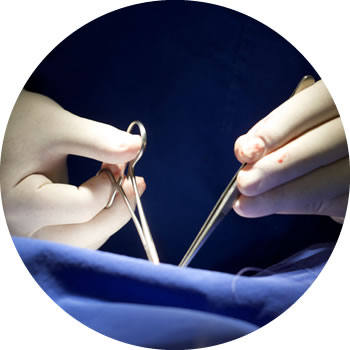Facial Skin Lesions
Excision of Skin Lesion
The problem
You have a lesion on the skin of your face that requires removal. It will already have been discussed with you that this is the best form of treatment rather than using creams, lotions or freezing the area. The removal involves a local anaesthetic, ie: you are going to be awake but the area will be numb so that you feel no pain.
What does the operation involve?
First the area in and around the skin lesion will be frozen with a local anaesthetic injection. This takes a few minutes to work. An antiseptic solution may then be used to clean the area and special ink used to mark out the piece of skin to be removed. The amount of time that the removal takes obviously varies depending on the size of the area involved but typically it may take between 20 and 30 minutes.
Is anything done after the area is removed?
Removal of the lesion leaves a hole in the skin. This hole can be repaired in one of three ways:
If the hole is small the surrounding skin can be gently pulled together with stitches. Some of these stitches may be dissolvable but often stitches on the skin need removal after a week. Most skin lesions can be removed and repaired in this simple way.
If there is not enough loose skin next to the hole to allow the edges to be stitched directly then a neighbouring area of skin can be partly lifted and moved round to fill in the hole. This ‘flap’ is then stitched into place. Once again a combination of dissolvable and removable stitches are often used. If it is necessary to raise a flap this does leave a larger scar but wherever possible the flap will be designed such that the scar lies in natural skin creases.
If a large area of skin has been removed it may be necessary to repair the wound with a piece of skin taken from elsewhere. Such a ‘graft’ is often taken from behind the ear or just above the collarbone. These sites are chosen because they already have an excess of skin. The graft is then laid over the area where the facial lesion has been removed and sewn into place. A dressing is put over the graft for around 10 days.
Which method of skin closure is best for you will be discussed with you before you sign any consent form for your operation.
What should I expect afterwards?
There will be some mild pain and discomfort once the numbness of the local anaesthetic injection has worn off. You may need to take simple painkillers (eg aspirin, Ibuprofen). There is a variable amount of swelling and bruising which tends to be worse for the first few days after surgery but has usually settled after a fortnight.
Do I need to take any time off work?
If you have a local anaesthetic then you can drive yourself to and from hospital on the day of your operation. Depending on the type of work you do it may be best to take the rest of the day off. If the lesion that you are going to have removed is close to your eye it would be best if you could bring somebody with you to drive you home in case your vision is altered by any swelling.
What are the possible problems?
Bleeding is uncommon. Should it occur it can usually be stopped by applying pressure over the area for at least 10 minutes with a rolled up handkerchief or swab. Infection is also uncommon but if the doctor carrying out the surgery thinks it might happen you will be given an antibiotic ointment or tablets.
Will I need further appointments?
You will obviously need any dressings or stitches removed and an appointment for this will be arranged before you leave hospital. It is important to keep any dressings or stitches dry until they are removed. It is routine for any skin lesions to be sent for examination under a microscope so that we can tell you what the lesion was and whether it has been completely removed. This test takes time to carry out and the results may not be available for a couple of weeks.

